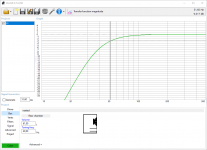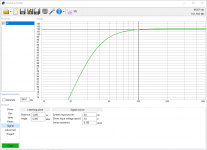A totally different design approach to the OPs initial proposal
I detect sarcasm, but a 2.5 way isn't really that different to a 2 way design.
...and going bigger is literally the only way to meet 2/3 of the goals of their proposal, so something has to change.
"1) High efficiency 2) Small foot print 3) Bass extension."
The OP simply cannot get this from any box that is approximately the same size as their existing boxes.
...particularly when a stand mount is at a disadvantage relative to something like the Pencil enclosures, which have their ports abutting the floor (for better boundary loading).
Do you know what the technical reasons are? Any descriptions available? I thought that nearfield/farfield speaker is a matter of angles and phase throughout the acoustic field and this would essentially be set by the horn/waveguide in case of a CD. But obviously there is more to it?!Not so long ago I contacted Faital Pro and they confirmed that the HF108R is indeed developed for shorter listening distances, like home, studio etc.
Beauty! I would love to learn more about it. Maybe show us somewhere else?I've designed a speaker with exact drivers of your second option. Faital Pro 8PR200 and HF10AK + STH100.
binachi, WinISD
WinISD - Linearteam
Loudspeaker data:
Loudspeaker Database
import from there to WinISD
Take Faital 12PR320 12-inch with FS of 42 Hz and put it in your 61 liters enclosure. Build it 34 cm wide and 36 cm deep with 18mm wood. This is the smallest baffle width possible, aka foot print. They seem "slim" then. Put the ports on the front baffle so you can use the speakers closer to the wall if you need boundary gain. Tune the enclosure to 40 Hz and build the speaker 80 cm high, which is good to put your favored compression driver at you ears height and necessary for volume. You get F3 of 52 Hz, should suffice your needs. Also, 101 db @ 1 meter @ 6 watts or 94 dB @ 2.5 meters @ 6 watts. Horribly loud. This is the best you can get if you want to go passive and low and relatively slim. Now you need to read alot about electronics to construct the crossover, so many graphs! And very time consuming.
Enclosure 34 x 36 x 80 cm (-3,6 cm each for internal volume of 61 liters), tuned to 40 Hz, WinISD simulation attached.
Attachments
I agree with hollownboy for the reasons stated. If ever a situation called for a 2.5 way, this is one of them. My other suggestion would be to replace the Klipsch but that’s because I don’t like having multiple tools for the same job.
Try starting here, and then clicking through to what you want.
Calculators
...or just search for any speaker calculator. There are several that work online, others that you download (e.g. to run in Excel), and others that are an .exe like Hornresp.
Thanks.Lots of stuff I can use.I guess I've got some homework to do.
GrahamGraham.I was on your suggest site but couldn't find anything using Faitalpro drivers.
Do you know what the technical reasons are? Any descriptions available? I thought that nearfield/farfield speaker is a matter of angles and phase throughout the acoustic field and this would essentially be set by the horn/waveguide in case of a CD. But obviously there is more to it?!
I can only write the info that can be found on the internet about the HF108R anyway.
If the claims about that driver are true or not I don't know, because I didn't compared to the HF108, but I compared to the ND1090 (which is almost the same as the good known NSD1095, but the ND1090 measures even better) and the HF108R creates a much more "civilized" sound subjectively than the Titanium Eighteen Sound, which sometimes sounds like it wants to shave your hair. Although that latter driver has a metal diaphragm obviously.
Test Bench: Faital Pro HF108R Compression Driver | audioXpress
ND1090 vs NSD1095 vs 1" CD-s:
Grand Comparatif de Compressions 1 pouce - JustDIYIt !
Last edited:
The HF108 is one of the best sounding CD tweets out there and is silky smooth and detailed.
Love it, the 10AK is also a favorite! They are incredible drivers for the money.
Love it, the 10AK is also a favorite! They are incredible drivers for the money.
I just spent a couple of hours on WinISD and experienced extreme frustration. I read the tutorials but could not get started due to missing info.
1) There are no drivers listed in the SELECT DRIVER FOR PROJECT list.
2) I entered T/S parameters for the driver I wish to use but wasn't able to save it so lost everything.
Is there a problem with this app or is it just me that doesn't know how to use it? I down loaded version 0.7.0.950.
1) There are no drivers listed in the SELECT DRIVER FOR PROJECT list.
2) I entered T/S parameters for the driver I wish to use but wasn't able to save it so lost everything.
Is there a problem with this app or is it just me that doesn't know how to use it? I down loaded version 0.7.0.950.
Last edited:
WinISD might be saving the driver info in a unnamed "arrowed" tab at the very top of the listed drivers. My install of WinISD does this.
I can't tell you why. I've the same ver. # as you and it works fine. Maybe wipe it and reinstall?
This thread need more pictures.
I’m very interested in following this project especially if you end up with 50l 10” 2-way I’m sure it’s doable if you accept some limitations (room size).
But the thread need pics. Of room. Of speaker plans. Simulations. Similar projects by others.
I’m very interested in following this project especially if you end up with 50l 10” 2-way I’m sure it’s doable if you accept some limitations (room size).
But the thread need pics. Of room. Of speaker plans. Simulations. Similar projects by others.
Since one of my requirements is a small foot print, my first choice of speaker size is an 8 inch in a 40l maybe 50l box. Dave123 and GrahamGraham can you give us your thoughts on your speakers? Dimensions? Hence volume? How is the bass? What type of music do you listen to? Do you think the Fs 58Hz of the 8PR200 to be sufficient for rock, classic rock, prog?
Glad you guys jumped in.
Hollowboy: For some reason I can't get access to the calculator.
BTW, what is meant by " tuned to xx Hz".Is this done by playing with port dimensions?
Thanks
in 40-50l bass reflex box you'll get frequencies down to ~50hz. in room response will be a little better. I used ~90 liter with in-room response good from ~45hz. all in all it is a good speaker and fun to listen to. I crossed them 2.8khz 4th order LPF and 2nd order HPF Butterworth. I built autotransformer to attenuate the tweeter.
As soon as I figure out WinISD I'll test 2 designs that I have come up with, a 54 Litre and a 78 Litre. Not sure which one yet. Is there a better online calculator out there that I can use without the WinISD bugs?
I'll try reinstalling it and see what happens.
I'll try reinstalling it and see what happens.
head to loudspeakerdatabase.com and see if the drivers are there. There is an online box planner if I remember. If not, you can download WinISD format, or hornresp or what ever. Hornresp and VituixCAD can show what a box does as well but the WinISD is the easiest one I think.
Why don't you use this driver, Box is 80l tuned to around 30Hz. 10" woofer is PHL 3002
Here is a link to a good thread about this woofer. Use the HF108 in a suitable horn and it should be killer!!!!!!!!!!!!!!!
Flatter than flat. PHL 10" and Beyma 1,4"
Here is a link to a good thread about this woofer. Use the HF108 in a suitable horn and it should be killer!!!!!!!!!!!!!!!
Flatter than flat. PHL 10" and Beyma 1,4"
As soon as I figure out WinISD I'll test 2 designs that I have come up with, a 54 Litre and a 78 Litre. Not sure which one yet. Is there a better online calculator out there that I can use without the WinISD bugs?
I'll try reinstalling it and see what happens.
Install Vituixcad and press F3 on keyboard to use Enclosure tool.
WinISD is more advanced for bass response. Vituixcad is a general tool good for bafflestep and directivity and a lot more calculations, but not as specific. For what bianchi is up to now, he would be better with WinISD. Preloaded drivers are not necessary because in the end drivers will be requested which are not in the DB anyway. Simply use loudspeaker database and download .wrd file, save to winISD drivers folder, done. The program is not seamless, neither is soldering a x-over and carpentering an enclosure.
- Home
- Loudspeakers
- Multi-Way
- 2 way Faitalpro Horn Speaker build

